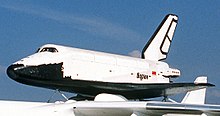


The Buran programme was an attempt by the Soviet Union to construct an orbital spaceplane to perform similar functions to the Space Shuttle. Similar to the Space Shuttle programme, an aerodynamic prototype and a number of operational spacecraft were planned for the Buran programme,[1] which were known as "Buran-class orbiters".

The aerodynamic testbed OK-GLI was constructed in 1984 to test the in-flight properties of the Buran design. Unlike the American prototype Enterprise, OK-GLI had four AL-31 turbofan engines fitted, meaning it was able to fly under its own power.[2]
The list does not include taxi tests without takeoffs. All of these missions were landed at the Gromov Flight Research Institute test base.
| No | Flight date | Crew | Duration | Notes | Sources |
|---|---|---|---|---|---|
| 1 | 10 November 1985 | 00d 00h 12m |
|
[3][4] | |
| 2 | 3 January 1986 |
|
00d 00h 36m | [3] | |
| 3 | 27 May 1986 |
|
00d 00h 23m | [3] | |
| 4 | 11 June 1986 |
|
00d 00h 22m |
|
[3] |
| 5 | 20 June 1986 | 00d 00h 25m |
|
[3] | |
| 6 | 28 June 1986 |
|
00d 00h 23m |
|
[3] |
| 7 | 10 December 1986 |
|
00d 00h 24m |
|
[3][4] |
| 8 | 23 December 1986 |
|
00d 00h 17m |
|
[3] |
| 9 | 29 December 1986 |
|
00d 00h 17m |
|
[3] |
| 10 | 16 February 1987 |
|
00d 00h 28m |
|
[3][4] |
| 11 | 21 May 1987 |
|
00d 00h 20m |
|
[3] |
| 12 | 25 June 1987 |
|
00d 00h 19m |
|
[3] |
| 13 | 5 October 1987 |
|
00d 00h 21m |
|
[3] |
| 14 | 15 October 1987 | 00d 00h 19m |
|
[3] | |
| 15 | 16 January 1988 |
|
00d 00h 22m |
|
[3][5] |
| 16 | 24 January 1988 |
|
00d 00h 11m |
|
[3] |
| 17 | 23 February 1988 |
|
00d 00h 22m |
|
[3] |
| 18 | 4 March 1988 |
|
00d 00h 32m |
|
[3] |
| 19 | 12 March 1988 |
|
00d 00h 20m |
|
[3][5] |
| 20 | 23 March 1988 |
|
00d 00h 43m |
|
[3][5] |
| 21 | 28 March 1988 |
|
00d 00h 19m |
|
[3][5] |
| 22 | 2 April 1988 |
|
00d 00h 20m |
|
[3] |
| 23 | 8 April 1988 |
|
00d 00h 21m |
|
[3] |
| 24 | 15 April 1988 |
|
00d 00h 19m |
|
[3] |
The first operational orbiter, Buran flew one test mission, designated 1K1, on November 15, 1988 at 6:00:00 Moscow time.[6] The spacecraft was launched uncrewed from and landed at Baikonur Cosmodrome in the Kazakh S.S.R. and flew two orbits, traveling 83,707 km (52,013 mi) in 3 hours, 25 minutes (0.14 flight days).[7] Buran never flew again; the program was cancelled shortly after the dissolution of the Soviet Union.[8] In 2002, the collapse of the hangar in which it was stored destroyed the Buran orbiter.[9][10]
| No | Launch date | Mission | Shuttle | Crew | Duration | Landing site | Notes | Sources |
|---|---|---|---|---|---|---|---|---|
| 1 | 15 November 1988 03:00:01 UTC 06:00:01 MSK |
1K1 | Buran | 0 | 00d 3h 25m | Baikonur |
|
[11][12][13] |
| No | Launch date | Mission | Shuttle | Crew | Duration | Landing site | Mission details |
|---|---|---|---|---|---|---|---|
| 2 | Q4 1991 | 2K1 | 1.02 | None | 2d | Baikonur |
First flight of 1.02 |
| 3 | Q1-Q2 1992 | 2K2 | 1.02 | None | 7-8d | Baikonur |
Mir docking |
| 4 | 1993 | 1K2 | Buran | None | 15-20d | Baikonur | |
| 5 | 1994 | 3K1 | 2.01 | 1d | Baikonur |
First crewed flight | |
| 6 | 1994 | two cosmonauts | Baikonur | Second crewed flight | |||
| 7 | 1994 | two cosmonauts | Baikonur | Third crewed flight | |||
| 8 | 1995 | two cosmonauts | Baikonur | Fourth crewed flight | |||
| 9 | 1995 | two cosmonauts | Baikonur | Fifth crewed flight Last planned orbital test flight |
Due to shortening of the program and delays in second flight preparations, mission plan for second orbiter included almost all significant test tasks.
| No | Launch Date | Mission | Shuttle | Crew | Duration | Landing Site | Mission details |
|---|---|---|---|---|---|---|---|
| 2 | 1992 | 2K1 | 1.02 | None | 7-8d |
Mir docking |
|
Spaceflight lists and timelines
| |||||||||||||||||
|---|---|---|---|---|---|---|---|---|---|---|---|---|---|---|---|---|---|
| |||||||||||||||||
| General |
| ||||||||||||||||
| Human spaceflight |
| ||||||||||||||||
| Solar System exploration |
| ||||||||||||||||
| Earth-orbiting satellites |
| ||||||||||||||||
| Vehicles |
| ||||||||||||||||
| Launches by rocket type |
| ||||||||||||||||
| Launches by spaceport |
| ||||||||||||||||
| Agencies, companies and facilities |
| ||||||||||||||||
| Other mission lists and timelines |
| ||||||||||||||||
|
| |
|---|---|
| Components |
|
| Orbiters |
|
| Sites |
|
| Testing |
|
| Support |
|
| Space suits |
|